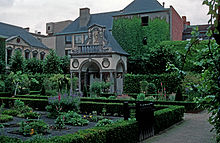The Garden of Love (Rubens)
[2] It is the apotheosis of the outdoor courtly Merry Company genre painting, and anticipates the French Fête champêtre type of the next century.The subject of this piece is common in Baroque paintings, which used exaggerated motion and clear, easily interpreted detail to produce drama, tension, and grandeur.[3] Cupids interact with the individuals, bringing mythological figures into a realistic garden scene to produce a fantastical painting.[4] All around the group, symbols of matrimonial love can be found including: the cupids, a pair of doves, flower crowns, music making, and Juno’s peacock.The Garden of Love is believed to be celebration of his marriage to Rubens’ wife: Hélène Fourment.


RubensPrado MuseumRoyal Palace of MadridMerry CompanyFête champêtreBaroqueHélène FourmentRubenesqueAntwerpAdriaen BrouwerPeter Paul RubensThe Descent from the CrossLeda and the SwanThe DepositionSelf-Portrait in a Circle of Friends from MantuaEquestrian Portrait of the Duke of LermaPortrait of a Young WomanHercules and OmphaleHeraclitus and DemocritusVirgin and ChildThe Fall of PhaetonThe Baptism of ChristThe Gonzaga Family in Adoration of the Holy TrinityTransfigurationThe CircumcisionPortrait of Marchesa Brigida Spinola-DoriaPortrait of Maria di Antonio SerraPortrait of a Noblewoman with an AttendantPortrait of Giovanni Carlo Doria on HorsebackSaint Gregory with SaintsMadonna della VallicellaSusanna and the EldersThe Head of Saint John the Baptist Presented to SalomeAdoration of the MagiSamson and DelilahHoneysuckle BowerCoronation of the VirginJuno and ArgusRaising of the CrossConversion of Saint PaulMassacre of the InnocentsVenus FrigidaPrometheus BoundThe Four PhilosophersAntwerp ResurrectionVisitationRoman CharityEcce HomoDescent from the CrossSaint Teresa of Ávila's Vision of the Holy SpiritThe Tribute MoneyThe Defeat of SennacheribThe Four ContinentsChrist Giving the Keys to Saint PeterPortrait of a CommanderThe Crowning of the Virtuous HeroThe Incredulity of Saint ThomasThe Death of AdonisVenus and AdonisSt SebastianThe Virgin Mary and Saint Francis Saving the World from Christ's AngerMadonna della CestaIxion, King of the Lapiths, Deceived by Juno, Who He Wished to SeduceDaniel in the Lions' DenBacchanaliaA Statue of CeresThe Hippopotamus and Crocodile HuntThe Tiger HuntTheodosius and Saint AmbroseThe Wild Boar HuntFlorence ResurrectionThe Virgin and Child Surrounded by the Holy InnocentsErichthonius Discovered by the Daughters of CecropsThe Wolf and Fox HuntThe Lion and Leopard HuntRomulus and RemusMiracles of St. Francis XavierSaint Stephen TriptychTwo Women with a CandleThe Meeting Between Abraham and MelchizedekChrist and the Penitent SinnersMars and Rhea SilviaThe Garden of Eden with the Fall of ManThe Great Last JudgementA Bearded ManThe Five SensesTwo SatyrsMedusaThe Rape of the Daughters of LeucippusChrist Triumphant over Sin and DeathThe Prodigal SonThe Union of Earth and WaterTigress with Her CubsMucius Scaevola before Lars PorsennaFeast in the House of Simon the PhariseeSt Mary Magdalene in EcstasyThe Small Last JudgementThe Fall of the DamnedLandscape with Philemon and BaucisPortrait of a Young Man in ArmorSaint George and the DragonPerseus Freeing AndromedaSaints Dominic and Francis Saving the World from Christ's AngerThe Rape of Orithyia by BoreasChrist on the CrossThe Three GracesIsabella BrantThe Lion HuntMarie de' Medici cyclePortrait of Susanna LundenPerseus and AndromedaThe History of ConstantineSelf-PortraitThe Conversion of Saint BavoDiana and Her Nymphs Leaving for the HuntThe Reconciliation of Esau and JacobChrist Appointing Saint Roch as Patron Saint of Plague VictimsPortrait of Infante Isabella Clara EugeniaPortrait of George Villiers, 1st Duke of BuckinghamAssumption of the VirginAngelica and the HermitHenry IV at the Battle of IvryThe Triumphal Entry of Henry IV into ParisThe AnnunciationThe Fall of ManThe Rape of Europa